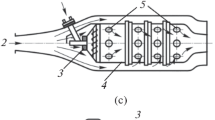Abstract
The paper is the first of a planned set of papers devoted to the world experience in development of Low Emission combustors (LEC) for industrial Gas Turbines (GT). The purpose of the article is to summarize and analyze the most successful experience of introducing the principles of low-emission combustion of the so-called “poor” (low fuel concentration in air when the excess air ratio is about 1.9–2.1) well mixed fuelair mixtures in the LEC for GTs and ways to reduce the instability of combustion. The consideration examples are the most successful and widely used aero-derivative GT. The GT development meets problems related to the difference in requirements and operation conditions between the aero, industrial, and power production GT. One of the main problems to be solved is the LEC development to mitigate emissions of the harmful products first of all the Nitrogen oxides NOx. The ways to modify or convert the initial combustors to the LEC are shown. This development may follow location of multiburner mixers within the initial axial envelope dimensions or conversion of circular combustor to the can type one. The most interesting are Natural Gas firing GT without water injection into the operating process or Dry Low emission (DLE) combustors. The current GT efficiency requirement may be satisfied at compressor exit pressure above 3 MPa and Turbine Entry temperature (TET) above 1500°C. The paper describes LEC examples based on the concept of preliminary prepared air–fuel mixtures' combustion. Each combustor employs its own fuel supply control concept based on the fuel flow–power output relation. In the case of multiburner combustors, the burners are started subsequently under a specific scheme. The can type combustors have combustion zones gradually ignited following the GT power change. The combustion noise problem experienced in lean mixtures' combustion is also considered, and the problem solutions are described. The GT test results show wide ranges of stable operation at needed levels of NOx and CO emissions. The world experience analysis and generalization and investigation of the further development directions for the high performance GT will assist development of domestic LEC for prospective GTs.
Similar content being viewed by others
References
“Trent 60 gas turbine,” Gas Turbine World 39 (3), 18–19 (2009).
M. Welch, “Flexible distributed power generation using the industrial Trent gas turbine,” in Proc. Power Gen Europe 2016, Milan, Italy, June 21–23, 2016.
T. Scarinci and C. Barkey, “Dry low emissions technology for the Trent 50 Gas Turbine,” (Rolls-Royce, Montreal, 2004). http://energybase.ru/equipment/trent-60-dle.
T. Scarinci, C. Freeman, and I. J. Day, “Passive control of combustion instability in a low emissions aeroderivative gas turbine,” in Proc. ASME Turbo Expo 2004: Power for Land, Sea, and Air, Vienna, Austria, June 14–17, 2004 (Am. Soc. Mech. Eng., New York, 2004), Vol. 1, pp. 487–499, Paper No. GT2004-53767.
A. H. Summerfield, D. Pritchard, D. W. Tuson, and A. David, “Mechanical design and development of the RB211 dry low emission engine,” in Proc. ASME 1993 Int. Gas Turbine and Aeroengine Congr. and Expo., Cincinnati, OH, May 24–27, 1993 (Am. Soc. Mech. Eng., New York, 1993), Vol. 3B: General, Paper No. 93-GT-245.
T. Lieuwen, “Combustion driven oscillations in gas turbines,” Turbomach. Int., No. 1, 16–18 (2003).
T. Scarinci and J. L. Halpin, “Passive control of combustion instability in a low emissions aero-derivative gas turbine,” ASME Paper 2004-GT-53767 (Am. Soc. Mech. Eng., New York, 2004).
T. Scarinci, “Combustion instability and its passive control: Rolls-Royce Trent 60 dry low emissions aeroderivative engine experience,” in Combustion Instabilities in Gas Turbine Engines: Operational Experience, Fundamental Mechanisms, and Modeling, Ed. by T. Lieuwen and V. Yang (Am. Inst. Aeronaut. Astronaut., Reston, VA, 2005), in Ser.: AIAA Progress in Astronautics and Aeronautics, Vol. 210, pp. 65–88.
M. A. Macquisten, M. Whiteman, and A. J. Moran, “Application of low order thermoacoustic network to DLE staged combustor,” in ASME Turbo Expo 2004: Power for Land, Sea, and Air, Vienna, Austria, June 14–17, 2004 (Am. Soc. Mech. Eng., New York, 2004), Vol. 1, pp. 733–741, Paper No. GT2004-54161.
N. D. Joshi, H. C. Mongia, G. Leonard, J. W. Stegmaier, and E. C. Vickers, “Dry low emissions combustors development,” in Proc. ASME 1998 Int. Gas Turbine and Aeroengine Congr. and Exhibition, Stockholm, Sweden, June 2–5, 1998 (Am. Soc. Mech. Eng., New York, 1998), Vol. 3, Paper No. 98-GT-310.
G. H. Badeer, “GE aeroderivative gas turbines — Design and operating features,” GE Power Systems, Paper No. GER-3695E (General Electric, Evendale, OH, 2000).
G. H. Badeer, “GE’s LM2500 + G4 aeroderivative gas turbine for marine and industrial applications,” GE Energy Paper No. GER-4250 (General Electric, Evendale, OH, 2005).
Y. Huang and V. Yang, “Dynamics and stability of leanpremixed swirl-stabilized combustion,” Prog. Energy Combust. Sci. 35, 293–364 (2009).
A. V. Ageev, “Thermal characteristics of gas turbine unit LM2500+ HSPT DLE at Belgorod GTU-TETs “Luch”,” in Proc. LIII Sci.-Tech. Session of the Russian Academy of Sciences on Problems of Steam Turbines, Moscow, Sept. 13–14, 2006 (Ross. Akad. Sci., Moscow, 2006), pp. 3–5.
S. Greenm, “Gas turbine technology — Unique union,” Power Eng. Int. 12 (1) (2004).
M. McNeely, “GE’s LMS 100, a “Game Changer”. New gas turbine combines frame and aero technology, achieves 46% efficiency,” Diesel&Gas Turbine Worldwide, No. 1, 38–44 (2004).
M. A. Mueller and J. A. Konkoly, Patent US No. 8567197 B2 (General Electric, 2013).
G. G. Ol’khovskii, Yu. A. Radin, A. V. Ageev, and A. I. Chertkov, “Thermal tests of LMS100 gas turbine units at Dzhubga TETs,” Elektr. Stn., No. 1, 11–20 (2016).
Author information
Authors and Affiliations
Corresponding author
Additional information
Original Russian Text © L.A. Bulysova, V.D. Vasil’ev, A.L. Berne, 2017, published in Teploenergetika.
Rights and permissions
About this article
Cite this article
Bulysova, L.A., Vasil’ev, V.D. & Berne, A.L. Low-Emission combustion of fuel in aeroderivative gas turbines. Therm. Eng. 64, 891–897 (2017). https://doi.org/10.1134/S0040601517120011
Received:
Accepted:
Published:
Issue Date:
DOI: https://doi.org/10.1134/S0040601517120011



